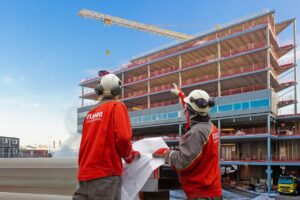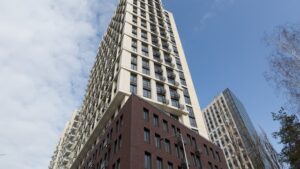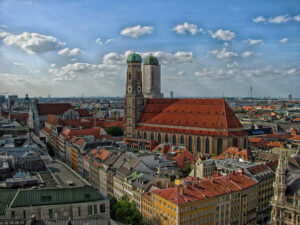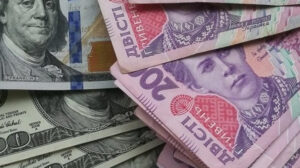
The construction market in Ukraine in the first half of 2025 showed mixed dynamics: on the one hand, there was noticeable growth in residential construction and activity in the vast majority of projects, and on the other hand, there was a slowdown in engineering infrastructure and persistent problems with demand. Below are the main findings and forecasts from the Experts Club analytical center.
According to the State Statistics Service, the volume of construction work performed in Ukraine in January-June 2025 reached ≈92.998 billion UAH, which is 8.15% more than in the same period of 2024. However, different sectors show different dynamics.
For example, the area of new construction of apartment buildings increased by ~45–46% compared to the first half of 2024, to ≈2.86–2.97 million square meters. At the same time, the volume of work on engineering infrastructure (roads, communications, etc.) in January-May 2025 decreased by ≈17.8% compared to the same period last year. At the same time, work on non-residential buildings increased by ~29.5%.
Experts also point to many problems in the industry, the most important of which are:
1) Demand for primary housing lags significantly behind supply: many new properties are being built, but buyer activity is not keeping pace with the growth in supply.
2) Inflation (general and construction prices) and rising material costs are affecting construction costs and completion times.
3) The labor shortage is growing month by month, which could have a significant impact on the industry as a whole.
Forecasts for the second half of 2025 and the end of the year
Annual growth in the construction industry (including all segments: housing, infrastructure, commercial construction) is expected to be ≈16% in nominal terms, mainly due to the low base effect and active participation of international aid and state funding.
Private developers are likely to continue expanding their housing supply, especially in large cities and regions with high demand (Kyiv, Lviv, Ivano-Frankivsk, etc.).
The infrastructure segment may remain weak unless government orders and investments, including international ones, are accelerated.
The building repair and renovation sector may receive an additional boost from reconstruction and restoration programs following destruction and wear and tear.
The Ukrainian construction market in the first half of 2025 is showing some signs of recovery, especially in the residential segment: the volume of work has increased, the construction of apartment buildings has increased, and business confidence has improved. However, the sustainability of growth is still limited: engineering infrastructure is the weakest link, and there are risks of declining profitability and slowdown if issues with material prices, staffing, and the legislative and regulatory environment are not resolved.

A decrease in supply on the residential real estate market in Kyiv and stable demand from buyers are maintaining the upward trend in prices for new buildings. By the end of the year, the cost per square meter will increase by 10-15%, the DIM group of companies told the Interfax-Ukraine agency.
“According to analysts at the DIM group of companies and industry observations, if the pace of the second half of the year does not fall below that of the first, the city will receive approximately 12-14 thousand new apartments by the end of the year, which is 15-20% less than last year. At the same time, limited supply amid stable demand will contribute to a further 10-15% increase in prices in the primary market by the end of the year,” the group said in a statement.
According to DIM, in the first half of 2025, the average price of new buildings increased by approximately 14% compared to the same period last year. Thus, , the average cost per square meter in new buildings is currently about $1,000/sq. m in the “economy” segment, $1,300/sq. m in the “comfort” segment, $2,200/sq. m in the ‘business’ segment, and $4,400/sq. m in the “premium” segment.
At the same time, the rate of increase in housing prices on the secondary market in the capital is slower: in the first half of 2025, prices rose by 8-10%, and the average cost per square meter on the secondary market is $2,000/sq. m.
According to Arseniy Nasikovsky, junior partner at DIM, the ability to move into ready-built housing is the main factor in choosing housing on the secondary market. However, a further reduction in the supply of new buildings in the event of a deterioration in the security situation will also shift the focus to secondary market properties.
“The choice between primary and secondary housing in 2025 will depend on the balance between readiness, risk, and the buyer’s financial capabilities. If the buyer values the ‘move in and live’ formula, they will choose secondary housing. New buildings offer a fundamentally different level of comfort, primarily a new level of security, which is very important in wartime, modern layouts, energy efficiency, and the availability of shelters and parking lots,” the expert explained.
According to DIM’s forecast, the restoration of new construction volumes to pre-war levels can be expected no earlier than the end of 2027. Today, there are only 140-145 residential complexes for sale on the capital’s market, which is a quarter less than before the war.
The portfolio of the development company DIM consists of real estate in Kyiv and the region with a total area of over 900,000 square meters. More than 3,600 apartments have been commissioned, and more than 356,000 square meters of residential and commercial space has been built. Six projects with a total area of more than 346,000 square meters are currently under construction.
Analysis, DIM, KYIV, REAL ESTATE, WHEAT

Vitamin D test has become one of the most demanded analyses in Ukraine, which surprises specialists, Deputy Director General of Sinevo Ukraine Mykola Skavronsky said in an interview with Interfax-Ukraine.
“I am a bit surprised by the great popularity of this expensive analysis. Moreover, it is paid for by the state through the medical guarantee program. Even many rich countries do not cover the vitamin D test at the expense of the budget,” he said.
Skavronsky noted that the popularity of the test is due to the active promotion of vitamin D preparations on the market since 2017-2018. “Pharmaceutical companies have made it part of the medical discourse, and the demand has taken hold,” he added.
“Synevo Ukraine is part of Synevo’s international laboratory network operating in more than 10 countries in Europe.”

In 2024, the German residential real estate market faced a number of challenges, including falling prices, slowing construction and rising borrowing costs. Here are the key trends and forecasts for 2025, focusing on the country’s largest cities.
Decline in housing prices
In the first half of 2024, the average asking prices for new and existing apartments decreased by about 3.6% compared to the same period in 2023. This decline is less pronounced than in previous periods, when the drop reached 7.3% and 7.4%, respectively. The largest annual decline was recorded in Frankfurt am Main – by 6.5%, while in Hamburg the decline was only 0.6%.
The situation in major cities
Munich: The most expensive city in Germany with an average price of about 11,000 euros per square meter. In 2024, there was a 5.2% decline in prices for new buildings.
Berlin: The average housing price was around 7,920 euros per square meter.
Hamburg: A 5% decline in new construction prices, which is one of the smallest declines among major cities.
Frankfurt am Main: The largest year-on-year price decline of 6.5%.
Düsseldorf and Leipzig: On the contrary, these cities recorded an increase in prices for new buildings by 4.1% and 8.7%, respectively.
Housing shortage and construction activity
According to a study by the Federal Institute for Building, Urban and Spatial Research (BBSR), Germany needs to build 320,000 new apartments every year until 2030 to meet growing demand, boosted by the influx of immigrants from Ukraine and Syria. However, in 2024, only 216,000 apartments were authorized, the lowest number since 2010 and reflecting the real estate crisis.
Financial performance and investments
Germany’s largest real estate group, Vonovia, reported its third consecutive annual loss in 2024, amounting to EUR 962.3 million, due to significant write-downs in property values. Nevertheless, CEO Rolf Buch predicts a return to profitability in 2025, provided that real estate prices stabilize.
Forecast for 2025
German house prices are expected to grow by 3.5% in 2025, although there is a significant risk of weaker growth. The market continues to face difficulties due to high borrowing and construction costs. Rental growth is expected to exceed house price growth, making it difficult for potential buyers to save a down payment.
In general, the German residential real estate market in 2024 was characterized by declining prices and slowing construction activity. Forecasts for 2025 suggest a moderate increase in prices, but the market remains sensitive to economic and political factors.
Source: http://relocation.com.ua/analysis-of-residential-real-estate-market-in-germany/

The National Bank of Ukraine has strengthened the official hryvnia-dollar exchange rate by 1 kopeck after the official hryvnia-dollar exchange rate was raised by 9 kopecks on Wednesday, according to the regulator’s website. – to 42.1729 UAH/$1, according to data on the regulator’s website.
The NBU set the reference rate at 12:00 Thursday at 42.1971 UAH/$1 against 42.2650 UAH/$1 a day earlier.
On the cash market, the dollar exchange rate fell by 21 copecks when buying – to UAH 42.61/$1, and when selling – by 17 copecks. – to UAH 42.70/$1.
In turn, analysts of the currency exchange market operator “KIT Group” for the near future predict the hryvnia exchange rate to remain in the corridor of 42-43 UAH/$1, looking at the stabilization process after a seasonal surge in demand for currency at the end of 2024.
“Low economic and business activity in January will contribute to the stability of the exchange rate on a short horizon. Evidence of this is the spread between the rates of buying and selling of the dollar: it remains relatively stable, which indicates the balance of supply and demand in the foreign exchange market of Ukraine”, – analysts note in the January review-forecast of the situation in the foreign exchange market.
According to their expectations, during the first half of the current 2025 hryvnia is very likely to weaken to 44 UAH/1$, which is fully consistent with the government’s budget forecast for this year.
“Avoidance of exchange rate extremes during the first half of the year will allow the National Bank and the economic block of the government to keep the exchange rate reserve to keep within the projected parameters of the average annual rate of UAH 45/$ according to the results of the current year”, – emphasize the experts of ‘KIT Group’.
At the same time, in their opinion, controlled devaluation may become one of the tools to fill the budget at the expense of duties and other fixed charges in foreign currency, including some excises.

France has one of the most complex and multi-level taxation systems in place, covering both legal entities and individual entrepreneurs. Let us consider the main taxes applicable to these categories of taxpayers.
Taxes for legal entities
1) Corporate income tax (Impôt sur les Sociétés, IS):
Its standard rate is 25% on company profits. A reduced rate of 15% is possible and applies to the first 38,120 euros of profit for small and medium-sized enterprises with an annual turnover of less than 7.63 million euros.
Some companies can choose between being taxed under the income tax system (Impôt sur le Revenu, IR) or the corporate tax system (IS), depending on their legal form and capital structure.
2) Value added tax (Taxe sur la Valeur Ajoutée, TVA), its rates are also diversified. The standard rate is 20%, and the reduced rates are: 10%, 5.5% and 2.1% are applied to certain goods and services.
3) There is also a tax called the territorial economic contribution (Contribution Économique Territoriale, CET). It consists of two components – a tax on the value of commercial real estate (Cotisation Foncière des Entreprises, CFE) and a contribution to the value added of business (Cotisation sur la Valeur Ajoutée des Entreprises, CVAE). The rates depend on the location and turnover of the company; the maximum CVAE rate is 1.5% for companies with a turnover of more than EUR 50 million.
4) There is also a so-called vehicle tax (Taxe sur les Véhicules de Sociétés, TVS). It is levied on companies that use cars for commercial or business purposes. The rates depend on the type of vehicle, its age, and CO₂ emissions.
Taxes for individual entrepreneurs (IEs) are also quite complicated.
1) Income tax (Impôt sur le Revenu, IR) with a progressive scale from 0% to 45%, depending on annual income. The income of individual entrepreneurs is taxed on the same scale as the income of individuals. There are various taxation regimes for individual entrepreneurs, such as “micro-entrepreneur” with a simplified accounting and taxation system.
2) Social contributions – individual entrepreneurs are required to pay social and health insurance contributions, the amount of which depends on the type of activity and income level.
3) Value added tax (TVA). Individual entrepreneurs are required to register as VAT payers if their annual turnover exceeds certain thresholds, for example, for trade in goods it is 91,900 euros, and for the provision of services – 36,800 euros.
Like almost any other country in the world, there is a real estate tax (Taxe Foncière). It is levied on property owners, regardless of their residency status. The rates are determined by local authorities and depend on the cadastral value of the property.
There is also still a tax on residence (Taxe d’Habitation), which is levied on persons living in real estate as of January 1 of the reporting year. This tax is being gradually abolished for most households; the full transition is expected to be completed in the coming years.
The luxury tax or Impôt sur la Fortune Immobilière (IFI) is levied on individuals whose real estate in France is valued at more than EUR 1.3 million. There is a progressive scale from 0.5% to 1.5% of the property value.
The French tax system is characterized by a high degree of progressivity and diversity of taxes, which requires careful planning and accounting when doing business. It is recommended to consult with professional tax advisors to ensure compliance with current legal requirements and optimize the tax burden.
http://relocation.com.ua/osoblyvosti-podatkovoi-systemy-frantsii-na-kinets-2024-roku-styslyj-analiz/